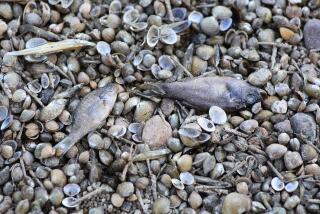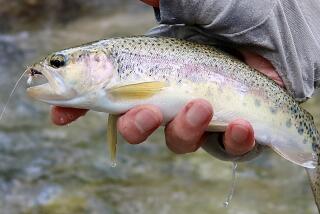Trout of the Frying Pan : But Never Into the Fire for These Monsters, Who Are Protected by Law and Nature in Their Lightly Fished Colorado Hideaway
- Share via
BASALT, Colo. — A thunderstorm crackled over the peaks of the Rocky Mountains, and sheets of rain pounded the majestic valley just north of Aspen.
But Len Walker did not care about the weather as he stepped from his pickup truck. Walker, 39, who stood a little more than six feet tall and packed about 190 pounds of muscle, was looking for a fight.
Nearby, the toughest guy on this block was starting to stir, too. Darting left and right, the brute dispatched a few intruders who had foolishly ventured into his territory, clearly identifying himself as the undisputed champion of the neighborhood. Soon, Walker would be locked in a brief but wild battle with this roughneck, instigating the combat by landing a sharp hook to the jaw.
Len Walker’s opponent on this cold, gray day was about 7 years old.
He weighed about 13 pounds.
He ate bugs.
*
Thirteen miles of fly-fishing heaven gushes into the world with a roar below the dam on Ruedi Reservoir in western Colorado, churning itself into a white froth for the first 50 feet before settling quickly into a typical trout stream, with sharp riffles, deep pools and hundreds of submerged boulders providing trout perfect spots to duck in from the swift current for a bite to eat.
The river is called the Frying Pan, which is an enormous misnomer because none of the fish that live in it end up in one. The river is managed by the Colorado Division of Wildlife and is heavily protected. All fishing is catch-and-release, and only artificial flies and lures with single, barbless hooks may be used by anglers.
Still, it is a fly-angler’s dream stream, a stretch of water bursting with so many fish that you can stand on its banks and see them--brown trout and rainbows feeding on insects along the bottom and on the surface, huge fish that sometimes pounce on drifting bugs atop the quiet pools with a body-slamming whack that can make an angler’s pulse race.
If ever a fly-fisherman is going to have a heart attack and die in mid-cast, it probably will happen here, as the absolute stillness is shattered by a 12-pound rainbow trout breaking clear of the water with a stroke of its massive tail and slapping back down onto the surface with a cannonball splash.
It is a jolt simply to see the Frying Pan with its enormous population of gigantic trout and realize that very few anglers are working its 13 miles. On a weekend, 35 or 40 people straight out of an Orvis catalogue appear. On weekdays, even at the peak of the summer tourist season, as few as 25 anglers might be seen, each working a stretch of 100 yards to a mile or more in absolute solitude.
The reward, besides the elbow room, comes in the form of trout that average 15 or more inches and routinely run three or four pounds.
And in the stretch where the Frying Pan is born, in the first 100 feet after Ruedi Dam, rainbows up to 15 pounds swim and feed voraciously in what seems less like a school and more like a ravaging pack. And here, where the winter water is the same temperature as the summer water as it roars out of the bottom of the 300-foot deep reservoir, making January, February and March fly-fishing a possibility, few anglers venture. For days at a time, no one will visit, ignoring the trout of a lifetime, leaving the monsters to gorge themselves in peace on tiny freshwater shrimp and insects.
Len Walker was about to find out why.
*
The rain eased and a few rays of sunlight sneaked through the clouds as Walker slipped into the clear water in silence, having planned his assault from a ridge 15 feet above the river.
What Walker had seen left him nearly speechless. At the end of the deep pool created by the pounding water, the sunlight dappled the surface and penetrated three or four feet to the bottom of the rock-strewn
river. Every once in a while, a form appeared in that mottled light, a form that Walker knew must be a trout.Still, even seeing it with his own eyes, he couldn’t quite believe it.
Some of these fish would stretch a tape measure to 30 inches or more, Walker estimated. Even more impressive was the girth of the monsters and their thick, massive tails.
After half an hour of observation, Walker had fashioned a four-foot section of fine tippet to his already-thin leader that had a breaking point of only 1.9 pounds--thread, really.
But Walker knew from talking to local anglers and from observing these fish that anything heavier would be a waste of time. These trout had grown to this size by examining every particle of food with great care.
To the end of his leader, Walker tied a hare’s ear nymph, a fly so small that a dozen could easily fit on a man’s fingernail, a puff of nearly weightless fur and feather tied onto a hook only slightly larger than this: J.
And now Walker stalked, moving each booted foot in the swift current just a few inches at a time until finally he was in position about 35 feet behind the end of the pool. After only five casts, the water boiled as a hulking trout rose to Walker’s fly and inhaled it inches beneath the surface.
Walker yelped as his graphite fly rod bent violently, the tip nearly in the water, the fish erupting at the bite of the steel hook and the shock of the sudden heaviness pulling at him.
*
Mike Costello knows the Frying Pan intimately, having visited its peaceful waters about 300 days a year for the last three years.
He found the Pan, as the locals call it, quite by accident, driving the back roads of Colorado at the tail end of a baseball career that blossomed at UC Riverside. Costello’s life at that time was mostly baseball, but inside, Costello was also a fisherman.
Weaned on the salmon-choked waters of a British Columbia river by a fishing-fool of a grandfather, Costello also had spent many days during his youth stalking the small and elusive trout in the tiny creeks of the nearby San Gabriel Mountains.
As he drove alongside the Frying Pan River a few summers ago, the fisherman in him re-emerged.
Today, Costello, 26, is a full-time fly-fishing guide in Basalt, working for veteran angler Roy Palm, who owns Frying Pan Anglers, a fly-angler’s candy store. And perhaps with the exception of Palm, who has had many more years to study the subtleties of the Frying Pan, Costello may be its most knowledgeable angler.
“The 65 days that I’m not fishing or guiding on the Pan, I’m skiing at Aspen,” Costello said. “I consider this my job. I really do. But usually, that idea seems so ridiculous to me that I laugh. I can’t imagine doing anything more enjoyable. But it is the way I make my living.”
Costello shows angler Rob Bresciani, a probation officer in Boulder who is still learning the intricacies of the sport, how to drift a tiny nymph through a fast but deep pool on the Frying Pan. Within minutes, Bresciani’s rod has bent sharply and a solid, two-pound brown trout is heading downstream with a very excited law enforcement representative in close pursuit.
“It is an easy river to fish sometimes,” Costello said. “At other times, there can’t be a more difficult river in the country.”
*
Walker allows himself only a brief smile as the massive fish slams his fly. Quickly, though, the smile becomes a frown as the flashing silver fish with the bright crimson slash heads upstream, toward the turbulent water and heavy submerged boulders in the deep pool.
Walker has done everything he can do. His graphite rod cost nearly $350 a year earlier. Few fly rods in the world perform better. His reel performs flawlessly, the drag giving line with great precision just before the line’s breaking point.
But the line is so thin and the fish so great. From the opening seconds of this fight, the outcome was a foregone conclusion. Even Walker knew that. Less than 30 seconds into the brawl, it is all over. The giant fish has found his way to a rock, brushed the nearly invisible line against it and a moment later is swimming free.
Walker reeled in the remnants of a memorable moment and smiled.
“I knew I never had a chance,” he said. “I hooked one of these guys about two years ago. Same thing happened. Kept this one on the line quite a bit longer, though.”
*
Not all of the monsters get away. Rob Baxter of Basalt caught a 13-pounder in the heavy water recently. Somehow his light leader did not part on a rock and after a 30-minute battle, he slid the weary giant up against his waders and, using both hands, lifted the spent rainbow into the air.
After a quick photograph, Baxter eased the sparkling fish back into the water. A moment of resuscitation and the old fish slammed his tail hard against the water and was gone, having earned himself perhaps another year of life in one of America’s best trout streams.
More to Read
Sign up for Essential California
The most important California stories and recommendations in your inbox every morning.
You may occasionally receive promotional content from the Los Angeles Times.









